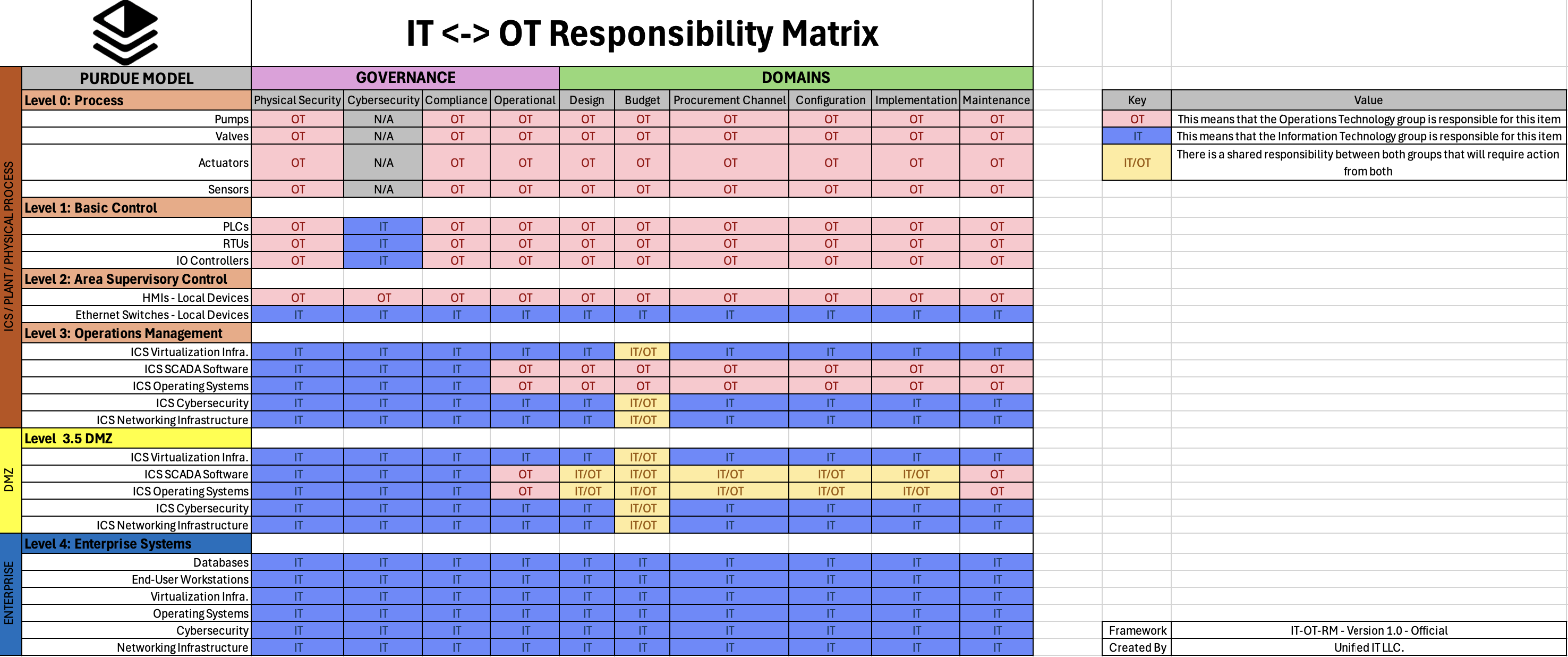Bridging IT and OT: A Unified Approach to Responsibility
In modern industrial environments, the boundary between Information Technology (IT) and Operational Technology (OT) is more interconnected than ever. Yet, this convergence often brings uncertainty around who owns what — particularly when it comes to cybersecurity, compliance, configuration, and maintenance.
To address this, Unified IT LLC created the IT ↔ OT Responsibility Matrix, a visual framework that establishes clear lines of accountability between IT and OT teams.
The Framework: Built on the Purdue Model
The matrix leverages the Purdue Enterprise Reference Architecture, a well-recognized model for defining industrial control system (ICS) layers — from Level 0 (Process) to Level 4 (Enterprise Systems) and the DMZ in between.
Each layer lists key assets — such as pumps, PLCs, SCADA systems, servers, and databases — and assigns responsibility across governance and operational domains, including:
- Governance: Physical Security, Cybersecurity, Compliance, and Operations
- Domains: Design, Budget, Procurement, Configuration, Implementation, and Maintenance
By distinguishing between IT, OT, and shared IT/OT responsibilities, the matrix provides a single, transparent view of how control, accountability, and collaboration flow across the organization.
Key Benefits
- Eliminates Overlap and Confusion: Teams know exactly which group is accountable for each asset and function.
- Strengthens Cybersecurity Posture: Defines ownership of cybersecurity responsibilities across both IT and OT systems.
- Simplifies Cross-Department Collaboration: Encourages coordination between engineering and IT teams, especially around shared infrastructure such as virtualization, networks, and cybersecurity.
- Improves Governance: Supports compliance and audit readiness by formalizing operational and technical ownership.
Example Insights
- Level 0–1 (Plant Floor): OT holds full responsibility for process devices and control logic.
- Level 2–3 (Supervisory & Operations): IT begins to share responsibility — especially for networking, virtualization, and cybersecurity.
- Level 3.5 (DMZ): Shared accountability between IT and OT ensures secure data flow between plant and enterprise systems.
- Level 4 (Enterprise): IT assumes full responsibility for corporate infrastructure, databases, and endpoints.
Conclusion
The IT ↔ OT Responsibility Matrix is more than a chart — it’s a governance tool for the modern industrial enterprise. By clearly delineating roles across both technical and operational domains, it empowers organizations to operate more securely, efficiently, and collaboratively.
Framework: IT-OT-RM Version 1.0 — Created by Unified IT LLC.



.png)



